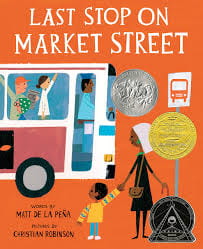Written by Matt de la Peña
Illustrated by Christian Robinson
In this engaging story, we walk the city streets and take the bus with CJ and his Nana, the two main characters, as they make their way to the soup kitchen where they volunteer weekly. In this beautifully illustrated story, Matt de la Peña takes us on a routine journey with CJ and highlights the young boy’s observations of socioeconomic differences in his own life and the life of the people he helps.
After wishing things were different, CJ’s Nana illuminates the beauty in the world around him and begins to see that recognizing the beauty in your world is what matters most. Through their afternoon together, we see a young boy go from feeling sorry for himself to feeling empowered and grateful for his community and life.
Additionally, Matt de la Peña showcases diversity through socioeconomic status, race, and family structure in just a few short pages. Last Stop on Market Street connects with the Teaching Tolerance standards in two distinct ways. The first is by incorporating the change of thought that happens to CJ and his socioeconomic identity. The second is by giving students a real actionable task they too can go and do to help people in their own community.
This book can be used in so many wonderful ways in the classroom. Whether it’s an art project on examining the beauty in your own life and showcasing it through a collage inspired by Christian Robinson’s illustrations or by giving students activist tasks they can do to be a part of the supports in their community by offering resources of volunteer opportunities in local shelters and soup kitchens, we are able to.

I Love that you draw out the power of the illustrations. They are not something I have spent a lot of time thinking about and I think the idea of collage would be so fun.
I’ve not really thought about this before — I mean it is Matt de la Peña after all and it did win the Caldecott & Corretta Scott King — but I’m thinking about the message of “be grateful for what you have,” and wanting to unpack that a bit. Of course the message is powerfully demonstrated (I love the bus ride and the weekly community meal). Maybe CJ’s comments about the bus could be seen as social commentary rather than complaining? Who rides the bus? What are all the different reasons for using public transportation? It might even start a qood “notice and wonder” about how public transportation works in children’s neighborhoods!